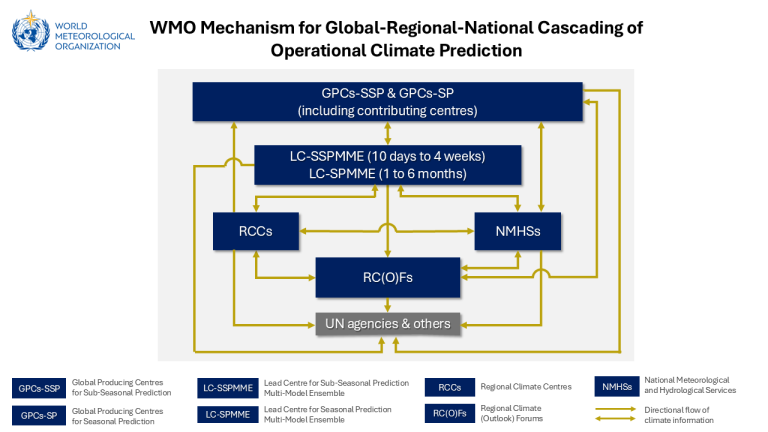WIPPS Seasonal Prediction
Since forecast accuracy decreases with longer lead times, WIPPS-DCs operate under a specialized structure to improve prediction quality. Each timescale - sub-seasonal, seasonal, and annual-to-decadal - has its own Global Producing Centres (GPCs) and a Lead Centre responsible for coordinating multi-model ensemble forecasts. To ensure robust model ensembles, sub-seasonal and annual-to-decadal predictions also incorporate data from non-designated centres that meet the criteria to become GPCs but are either awaiting designation or have not applied yet.
Beyond producing forecasts, all GPCs contribute to research, share advances in prediction techniques, and support Regional Climate Centres (RCCs) and National Meteorological and Hydrological Services (NMHSs) with guidance on climate predictions.
Sub-seasonal prediction
Five GPCs and five non-designated centres provide daily-averaged sub-seasonal prediction products for a minimum of four weeks, following the standards outlined in the Manual on the WIPPS (WMO-No. 485). These data are submitted weekly to the Lead Centre for Sub-seasonal Prediction Multi-model Ensemble (LC-SSPMME), which generates multi-model ensemble prediction products from the submitted data. The LC-SSPMME provides these products in both graphical and digital formats, along with individual centre products, and verifies the hindcast accuracy of each centre using the standardized metrics specified in the Manual.
Seasonal prediction
Fifteen Global Producing Centres for Seasonal Prediction (GPCs-SP) provide monthly-averaged seasonal prediction products—defined in the Manual on the WIPPS (WMO-No. 485)—with a minimum forecast range of three months. These products are submitted monthly to the Lead Centre for Seasonal Prediction Multi-Model Ensemble (LC-SPMME), which generates multi-model ensemble prediction products based on the contributed data.
The LC-SPMME provides these products in both graphical and digital formats, along with the individual digital products and standardized graphical outputs from each centre. It also verifies the hindcast accuracy of each centre using the standardized metrics specified in the Manual and publishes the results in both graphical and digital formats.
Additionally, the LC-SPMME prepares the Global Seasonal Climate Update (GSCU), which is made available on its website.
Since seasonal prediction products are currently the most widely used by WMO Members, Regional Climate Centres, and Regional Climate Forums, a detailed description of these products and the working mechanism between the GPCs-SP and the LC-SPMME.
The following schematic diagram shows WMO Mechanism for Global-Regional-National Cascading of Operational Climate Prediction for sub-seasonal and seasonal time scales.

For annual to decadal prediction
Four GPCs-ADCP and twelve non-designated centres provide their monthly-averaged prediction products which is defined in the Manual on the WIPPS (WMO-No. 485), with a minimum forecast range of five years, to the Lead Centre for Annual to Decadal Climate Prediction (LC-ADCP), on an annual basis. GPCs-ADCP also provide verification products to the LC-ADCP. The LC-ADCP uses the collected products to generate multi-model ensemble products. These are made available in both standard graphical format across centres and digital formats, along with the individual digital products from each centre. Additionally, the LC-ADCP prepares the Global Annual to Decadal Climate Update (GADCU) and makes it available on its website.

